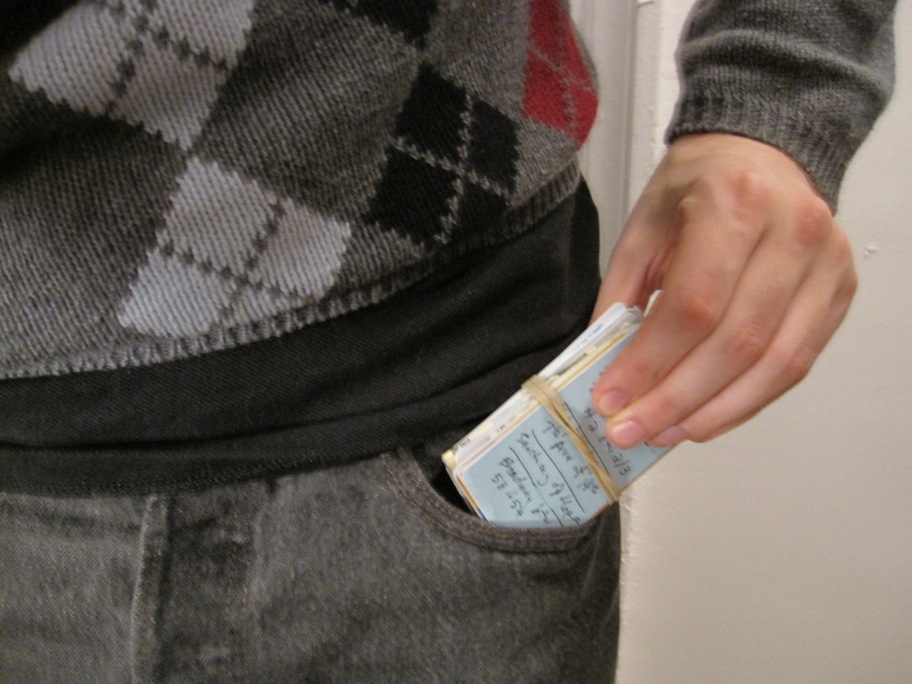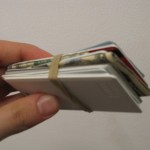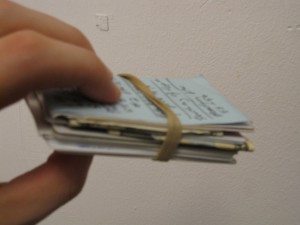
A friend recently suggested that I write a blog post about my wallet. Seemed like a good idea to me. When you look around at the literature on the internet about how to improve blog traffic, one of the suggestions that often comes up is to teach something that readers can use. And since The Row Boat is, by and large, self-indulgent reflection on deathless questions, the chance to write about something actually useful is not to be passed up. It’s a way of giving back to my readers—a dribble of self-help in exchange for all your thought and patience.
The extent of my wallet that doesn’t constitute its contents is very small: a rubber band. Until recently I actually used the hair-things that I was in the habit of stealing from my then-girlfriend—basically a rubber band wrapped in a coil of stretchy thread. The advantage of the hair-thing was the ease with which it could roll on and off the wallet’s contents. But when I lost the hair-thing, as well as the girlfriend from whom to steal a replacement, I was forced to choose from the stash of rubber bands under my desk, still hardly diminished since I bought them during the first week of college. To my surprise, the clingly quality of a thick, uncovered rubber band has grown on me. Those so inclined might try both and decide which they prefer.
 I came upon this species of wallet—which I have yet to see in any other incarnation than mine—out of necessity. It was a year or two ago, and I was traveling somewhere (don’t recall where) that made me concerned about pickpocketing sufficiently to want to have my valuables in the front, rather than back, pocket. A stolen hair-thing was handy (my hair was then long enough to warrant it), so I thought to wrap it, two times around, about the contents of my wallet. It immediately amazed me how much slimmer the package became without the clumsy leather folds that previously contained it. Once it comfortably settled into my front-left pocket, I was thrilled to discover also how much more comfortable sitting down had become now that one buttock no longer had a big wad of stuff between it and the seat. I was sold and never went back.
I came upon this species of wallet—which I have yet to see in any other incarnation than mine—out of necessity. It was a year or two ago, and I was traveling somewhere (don’t recall where) that made me concerned about pickpocketing sufficiently to want to have my valuables in the front, rather than back, pocket. A stolen hair-thing was handy (my hair was then long enough to warrant it), so I thought to wrap it, two times around, about the contents of my wallet. It immediately amazed me how much slimmer the package became without the clumsy leather folds that previously contained it. Once it comfortably settled into my front-left pocket, I was thrilled to discover also how much more comfortable sitting down had become now that one buttock no longer had a big wad of stuff between it and the seat. I was sold and never went back.
To paint a clearer picture of the practicalities of my method, let me take you on a tour of my particular arrangement. It is by no means the only option; in fact, I would love to hear from readers about other arrangements they find useful.
- On top, the pending department. Receipts to file and the back of a business card for short notes-to-self.
- Then the MVPs, MetroCard and credit card.
- Small bills, <$20, folded in thirds
- Two barrier cards: bank card and driver’s license. Ones that’ll never both be used at the same time so as not to combine the sections they separate.
- $20 bills, folded in thirds. So if you happen to have a stack of twenties, you don’t have to flash them when reaching for a single.
- The rest. Business cards, library cards, RFIDs of all kinds, stamps, etc.
- A back card, preferably robust and not scratchable. Whatever goes here takes a lot of punishment.
- The rubber band is wrapped around on the long side, tight and secure.
 Now that’s a pretty static arrangement. Another approach is to do what in computer programming is called a stack. The rule is very simple: whenever you put something back in the wallet, put it on top. Quite naturally, and with minimum effort, the things you most commonly use end up closer to the top and thus more accessible.
Now that’s a pretty static arrangement. Another approach is to do what in computer programming is called a stack. The rule is very simple: whenever you put something back in the wallet, put it on top. Quite naturally, and with minimum effort, the things you most commonly use end up closer to the top and thus more accessible.
Over time, I’ve found that my wallet behaves, in computer programming terms, more like an array—a data structure for which the cost of retrieval is equal at every location, so long as things remain where they’re supposed to go. Hence the more static structure detailed above. Plus, I’ve grown quite attached to separating big and small bills, a policy that could be threatened by the stack system.
I try to keep a stack system running in “the rest” area, while keeping the other areas staticly organized.
There you have it. A practical how-to session from Row Boat University. Not only did we cover a handy way to save pocket space, but a bit of computer science too! Isn’t it nice to do something practical for a change?
Comments
14 responses to “The Rubber Band Wallet”
A friend of mine told me her father started using this kind of wallet while traveling because the rubber band’s clingy nature makes it much harder to pickpocket. One more good reason to use it.
If you get two rubberbands, you can make a magic wallet out of it where money and loose receipts are in the center and easily put into the wallet. I’ve been using this for 2.5 years, and am always gleeful when I go to the supply closet and say “It’s time for a new wallet!”
Instructions:
1. Take two thick(must be the thick kind) rubberbands
2. Split your pile of cards into two stacks and put them side by side
3. Put rubberband over left stack (near the top), then twist it, and then put the right stack inside loop.
4. Put rubberband #2 under left stack (near the bototm), then twist it, and then put it on the right stack.
5. In order to make this work you have to make sure that the rubberbands on the right stack are twisted in such a way that both are on the “inside”, like the below “drawing”.
_____ _____
|_____| |
| |———|
| | |
|_____|———|
|_____|_____|
6. Then just put your money between both stacks and flip one stack to the other side, and voila!
Oh, I found a video: http://www.metacafe.com/watch/843725/diy_magic_wallet/
Drawing didn’t work….Just look at the video.
I use a similar arrangement. I prefer a thick produce band (like the kind that holds broccoli together). They last a long time, typically 6 months or more, and give plenty of friction to hold the assembly in your pocket. I’m not as organized about ordering the contents, but there are two things I always have: first, a folded sheet of letter-sized paper for notes, and second, a Fisher bullet space pen with a clip (http://www.spacepen.com/bullet.aspx). The pen is just a tiny bit longer than a credit card, and I can keep it tucked inside the fold of the paper, with the clip attached to the paper. Between the clip and the rubber band, the pen’s not going anywhere, and it’s always at hand.
Also a note, for the rubberband wallet, I also recommend that the outer four cards are cards you don’t care about as much as they will get super grimy (I use my Free Victoria Secret Panties card since I don’t care about actually getting it). Although, one of my outer cards is my work RFID badge though. Makes for some nice ass-beeping that the leather of a wallet might block out. It’s also nicely thick and stiff for the magic-walletness.
i think i might try this. i had a similar arrangement for a while when i was hiking, only i kept the whole shebang in a tyvek sleeve that my atm card came in, and on that i taped a piece of paper with “if found please mail to” info. i liked the organization and lack of bulk, but it wore out. lately i’ve been recklessly rocking the loose-in-my-pocket system, which I wouldn’t recommend to anyone.
Well, the verdict is in: practical advice is truly a boon for traffic! This article, with a helping hand from Reddit, brought in ten times more visitors in its first day than The Row Boat’s previous daily record. Wow. I gotta get out of the speculation business.
I have been using this type of ‘wallet’ for many years – through all forms of ridicule and jibing – it is nice to see that others have thought of this – as with Mike above, I use the bands used for broccoli – they are colorful, taught, and last a long time – and the broccoli is good to eat!
a very clever wallet. i am impressed
oops..i’m the one that gave the above comment, not nathan
[…] on a whim, I published a little post about my wallet. Since I usually try to keep to more straight-faced and world-historical things, writing about the […]
I was a rubber band user until I got fed up with it breaking all the time and sticking in my pocket. I wanted to make a better elastic “rubber band” wallet, so I invented the Bandit Wallet – http://www.banditwallet.com
The Bandit is made of durable, elastic fabric with exposed rubber gripper on the inside. The gripper secures your cash and cards like a rubber band. But, the material is smooth on the outside, so it slides easily into you pocket. And, the material is very durable – it won’t break like a rubber band.
The Bandit can hold as few as 3 cards or as many as 2″ worth. Check it out. I just launched this product in Feb of 2010.
I just stumbled upon your post. I too used to use a rubber band wallet. I got sick of it breaking all of the time. Check out the wallet I invented to stop that from happening that is really easy to use. At http://www.thexband.com. Their is no wallet like this one. Seriously… I’ve looked.
My old roommate turned my onto money-band. Took me al title while to get used to it, but now I’ll never go back to a regular wallet. The site is http://www.money-band.com I believe.